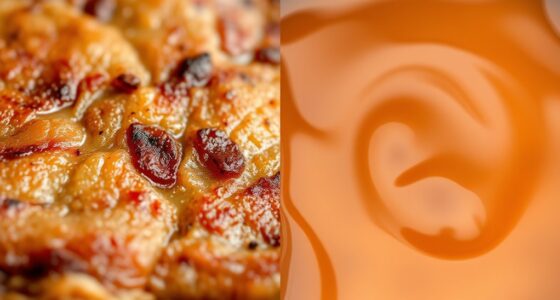When you knead dough, you physically manipulate the gluten proteins, helping them form a strong, elastic network quickly, resulting in a chewier texture. In no-knead methods, gluten develops gradually through long fermentation and stretch-and-fold techniques, creating a lighter, airier crumb. Both approaches rely on gluten’s ability to trap gases and give dough its structure, but they do so differently. Keep exploring to understand how these techniques affect your bread’s final texture.
Key Takeaways
- Kneading physically manipulates dough to rapidly develop gluten networks, increasing elasticity and strength.
- No-knead methods rely on extended fermentation and hydration to naturally form gluten without intensive kneading.
- Kneaded dough produces a firm, elastic texture ideal for chewy bread, while no-knead yields a rustic, airy crumb.
- Both techniques aim for optimal gluten formation to trap gases and enable proper dough rising.
- Choice of method influences final bread texture, with kneading emphasizing elasticity and no-knead favoring patience and gentle development.

Have you ever wondered how bread gets that chewy, elastic texture? It all comes down to gluten formation, a complex process that develops the dough’s structure. When you mix flour with water, gluten proteins—glutenin and gliadin—start to interact. As you knead the dough, these proteins form a gluten network, giving the bread its characteristic stretchiness. This gluten network is what gives dough its dough elasticity, allowing it to stretch without tearing, which is essential for trapping gas produced by yeast or other leavening agents. The more you knead, the stronger this network becomes, resulting in a chewier, more resilient bread. If you want a bread with a tight crumb and a chewy bite, vigorous kneading encourages a well-developed gluten network, providing the necessary structure to hold gases during proofing and baking.
On the other hand, no-knead doughs rely on a different approach to gluten development. Instead of vigorous kneading, they often use a longer fermentation process, sometimes combined with techniques like stretch-and-folds, to develop gluten naturally. During this slow fermentation, gluten proteins gradually form a strong, elastic network without requiring extensive kneading. This method allows gluten to develop more evenly and gently, resulting in a bread with excellent dough elasticity and a more open crumb. No-knead recipes are particularly popular for rustic breads, where a chewy, airy texture is desired, and the process emphasizes patience over physical manipulation. The key is that, even without kneading, enough gluten forms to give the dough its necessary structure and elasticity. This method can be more accessible for bakers who prefer a less labor-intensive process, yet still produce bread with a satisfying chew and good rise.
Whether you knead your dough or opt for a no-knead approach, understanding gluten formation helps you control the final texture of your bread. Kneading accelerates gluten development, leading to a firm, elastic dough that can stretch remarkably. Meanwhile, no-knead methods rely on time and hydration to weave the gluten network naturally. Both techniques aim to create a dough with the right balance of elasticity and strength, ensuring it can trap gases and rise properly. So, the choice between kneading and no-knead methods ultimately depends on the texture you want and how much effort you’re willing to put in. Recognizing how gluten network formation influences dough elasticity empowers you to experiment and perfect your bread-baking skills.
Frequently Asked Questions
How Does Hydration Level Affect Gluten Development?
Hydration level markedly impacts gluten development. When you increase hydration, the dough becomes wetter, which enhances gluten strength and elasticity. This hydration impact allows gluten strands to form more easily, giving your bread a chewier texture and better structure. Conversely, low hydration results in a stiffer dough with less gluten development, leading to denser baked goods. Adjusting hydration helps you control the dough’s texture and gluten formation process effectively.
Can Gluten Formation Occur Without Kneading?
Think of gluten formation like a symphony, where each instrument (or ingredient) plays a role. Yes, gluten network can develop without kneading, especially through the no-knead technique, which relies on long fermentation and hydration. This method allows gluten to form naturally as the dough rests, creating strength and elasticity. So, even without traditional kneading, your dough can still achieve a robust gluten network through patience and proper hydration.
What Role Does Resting Time Play in Gluten Structure?
Resting time helps develop a stronger gluten network by allowing the dough to relax, which makes it more extensible and easier to shape. During this period, gluten strands continue to form and strengthen, improving dough elasticity. You’ll notice the dough becomes smoother and less sticky. This process enhances gluten structure without additional kneading, giving you better dough handling and a more airy, well-structured final bread.
How Do Different Flours Influence Gluten Formation?
Different flours influence gluten formation based on their protein content. High-gluten flours, like bread flour, develop strong gluten networks, giving structure and elasticity. Alternative flours, such as almond or rice, contain little to no gluten, making them ideal for gluten-free options but requiring binders. You’ll notice that using different flours affects dough texture and rise, so choose wisely depending on whether you want traditional or gluten-free baked goods.
Is Gluten Formation Necessary for All Bread Types?
You might wonder if gluten formation is essential for all bread types. While traditional bread relies on gluten for structure and elasticity, some bread, like gluten-free options, doesn’t need it. In gluten-free baking, you use alternatives like xanthan gum or guar gum to mimic gluten’s properties. So, no, gluten formation isn’t necessary for all bread; you can enjoy delicious baked goods with gluten-free alternatives.
Conclusion
Now, whether you knead passionately or let your dough rest peacefully, remember that gluten formation is your secret ally in creating perfect bread. Like a symphony, each method plays its part, shaping texture and structure. So, embrace your choice—knead with energy or let patience do the work. After all, in the world of baking, it’s not just about the dough, but about crafting your masterpiece—so go ahead, make it your own.









